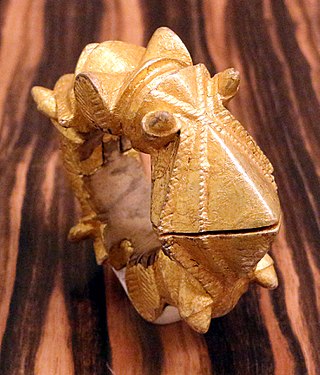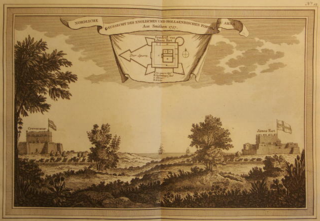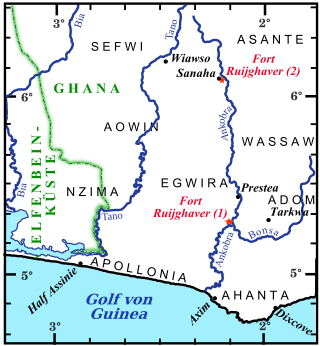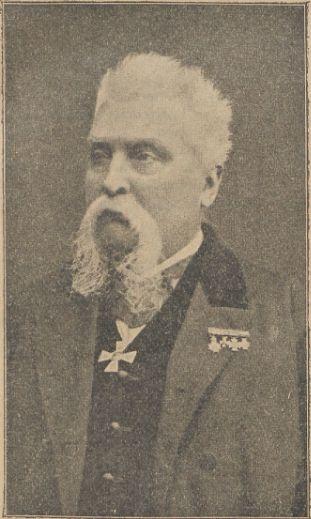
Elmina Castle was erected by the Portuguese in 1482 as Castelo de São Jorge da Mina, also known as Castelo da Mina or simply Mina, in present-day Elmina, Ghana, formerly the Gold Coast. It was the first trading post built on the Gulf of Guinea, and the oldest European building in existence south of the Sahara.

The Dutch Gold Coast or Dutch Guinea, officially Dutch possessions on the Coast of Guinea was a portion of contemporary Ghana that was gradually colonized by the Dutch, beginning in 1612. The Dutch began trading in the area around 1598, joining the Portuguese which had a trading post there since the late 1400s. Eventually, the Dutch Gold Coast became the most important Dutch colony in West Africa after Fort Elmina was captured from the Portuguese in 1637, but fell into disarray after the abolition of the slave trade in the early 19th century. On 6 April 1872, the Dutch Gold Coast was, in accordance with the Anglo-Dutch Treaties of 1870–71, ceded to the United Kingdom.

The Portuguese Gold Coast was a Portuguese colony on the West African Gold Coast along the Gulf of Guinea. Established in 1482, the colony was officially incorporated into Dutch territory in 1642. From their seat of power at the fortress of São Jorge da Mina, the Portuguese commanded a vast internal slave trade, creating a slave network that would expand after the end of Portuguese colonialism in the region. The primary export of the colony was gold, which was obtained through barter with the local population. Portuguese presence along the Gold Coast increased seamanship and trade in the Gulf, introduced American crops into the African agricultural landscape, and made Portuguese an enduring language of trade in the area.

The Treaty of Butre between the Netherlands and Ahanta was signed at Butre, Dutch Gold Coast on 27 August 1656. The treaty regulated the jurisdiction of the Netherlands and the Dutch West India Company over the town of Butre and the surrounding country of Upper Ahanta, creating a Dutch protectorate over the area, and permitting the establishment of Fort Batenstein. The treaty lasted until the Dutch departure from the Gold Coast in April 1872.

The Ahanta/Ayinda are Akan People who live to the north and east of the Nzema. The Ahanta land has been historically known as one of the richest areas on the coast of what is now Ghana.

Fort Nassau, near Moree, Ghana, was the first fort that the Dutch established on what would become the Dutch Gold Coast. Because of its importance during the early European colonial period in West Africa and its testimony to the African gold trade and the Atlantic slave trade, the fort was inscribed on the UNESCO World Heritage list in 1979.

Fort Coenraadsburg or Conraadsburg, also Fort São Tiago da Mina, is a small Portuguese chapel built in honor of Saint Jago and it is situated opposite the Elmina Castle in the Central region of Ghana, to protect Fort Elmina from attacks. Owing to its historical importance and testimony to the Atlantic slave trade, Fort Conraadsburg was inscribed on the UNESCO World Heritage List in 1979 along with several other castles in Ghana.

Fort Saint Anthony was a fort built by the Portuguese in 1515 near the town of Axim, in what is now Ghana. In 1642, the Dutch captured the fort and subsequently made it part of the Dutch Gold Coast. The Dutch expanded the fort considerably before they turned it over, with the rest of their colony, to the British in 1872. The fort is now the property of the Ghanaian state and is open to the public.

Ussher Fort is a fort in Accra, Ghana. It was built by the Dutch in 1649 as Fort Crèvecœur, and is two days' march from Elmina and to the east of Accra on a rocky point between two lagoons. It was one of three forts that Europeans built in the region during the middle of the 17th century. Fort Crèvecœur was part of the Dutch Gold Coast. The Anglo-Dutch Gold Coast Treaty (1867), which defined areas of influence on the Gold Coast, transferred it to the British in 1868. Because of its significance in the history of European colonial trade and exploitation in Africa, the fort was inscribed on the UNESCO World Heritage List in 1979.

Fort Batenstein was a fort and trading post established by the Dutch on the Gold Coast in 1656. It was situated near Butre. The fort was ceded with the entire Dutch Gold Coast to Britain in 1872.

The Anglo-Dutch Gold Coast Treaty of 1867 redistributed forts along the Dutch and British Gold Coasts in order to concentrate the parties' areas of influence. All forts to the east of Fort Elmina were adopted by Britain, and all forts to the west by the Netherlands.

Hendrik Carloff, Caerloff or Caarlof was an adventurer and slave trader active in the 17th century. Carloff began his career as a cabin boy but rose to become a commander and governor appointed by the Dutch West India Company and Danish or the Swedish Africa Company on the Gold Coast. Between 1676 and 1677, he was Governor of Tobago.

Fort Ruychaver, also Fort Ruijghaver, was a Dutch trading post in the hinterland of the Gold Coast, in contemporary Ghana. It existed between 1654 and 1660 on the banks of River Ankobra. The name of the post goes back to Jacob Ruijghaver, the director of the Dutch West India Company's possessions on the Gold Coast, who ordered its establishment.

Cornelis Johannes Marius Nagtglas was a Dutch politician and civil servant, who made a career in the administration on the Dutch Gold Coast. After originally beginning his career at the advanced age of 36, he was promoted through the ranks to eventually become Governor of the Dutch Gold Coast in 1858. He retired to the Netherlands in 1862, but returned to the Gold Coast as governor in 1869, to restore order in the embattled colony. In 1871, he left the Gold Coast again, one year before the transfer of the colony to the United Kingdom.
The Dutch–Ahanta War was a conflict between the Netherlands and the Ahanta between 1837 and 1839. Beginning with a mere economic dispute between the Ahanta and the Dutch, who were based at the Dutch Gold Coast, the conflict ended with the hanging of Ahanta king Badu Bonsu II and the reorganization of the Ahanta state, establishing a Dutch protectorate over the Ahanta.
The Treaty of Asebu was concluded in 1612 between the Dutch Republic and the chiefs of Asebu on the Gold Coast of Africa. The treaty was the first among several concluded between the Dutch and the peoples of the Gold Coast, and marked the beginning of a 260-year period of Dutch presence on the Gold Coast.
The Kingdom of the Netherlands has an embassy in the Republic of Ghana. It has a role in promoting trade between the countries.
Willem Pieter Antonie Le Jeune, born as Willem Pieter Antonie Tenwinkel, was a Dutch colonial administrator and diplomat, who made a career in the administration on the Dutch Gold Coast and who was interim governor between 28 October 1871 and 15 November 1871. After the Netherlands sold its possessions on the Gold Coast to the United Kingdom in 1872, Le Jeune became the first Dutch consul in Elmina.

The documented history of Elmina begins in 1482 with an agreement between the Portuguese navigator Diogo de Azambuja and the ruler of Elmina, called Caramansa by the Portuguese. In it, the Portuguese were allowed to build the first European fortress in sub-Saharan Africa. For the next 150 years until the conquest by the Dutch in 1637, Elmina was the capital of the Portuguese bases on the Gold Coast, then for about 250 years the capital of the Dutch Empire in West Africa. Since the capture of the lease for the two fortresses of Elmina by the Ashanti in 1701, the city was also important to the Ashanti Empire. Until the 19th century, Elmina was one of the most populous cities in the Gold Coast, surpassing Accra and Kumasi. The trade in gold, slaves and palm oil brought the city into direct contact with Europe, North America, Brazil and, through the recruitment of soldiers, also with Southeast Asia. It was not until the takeover and destruction of the city by the British in 1873 that Elmina lost its prominent position in the Gold Coast.















